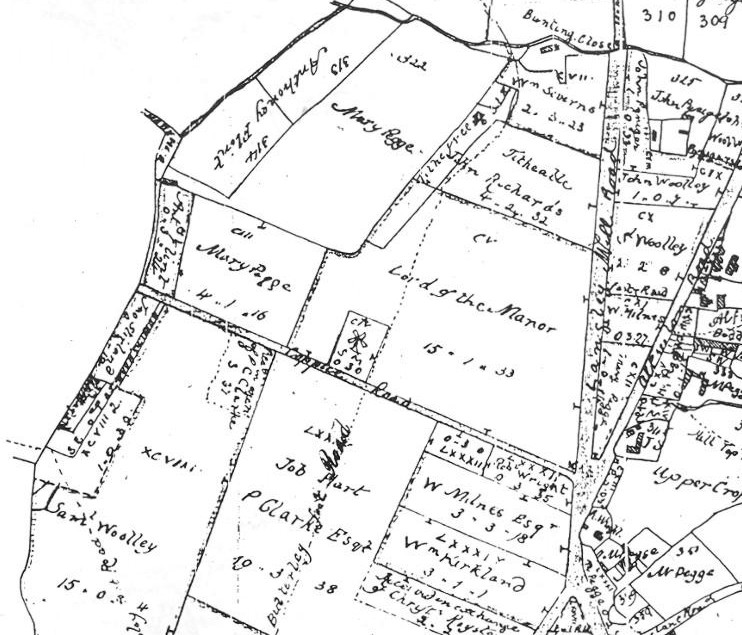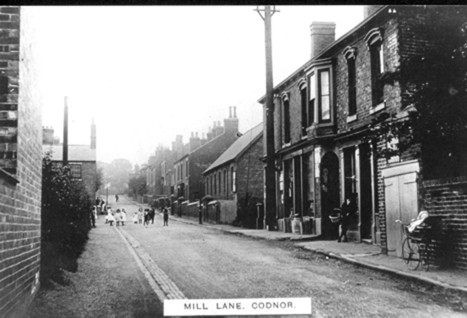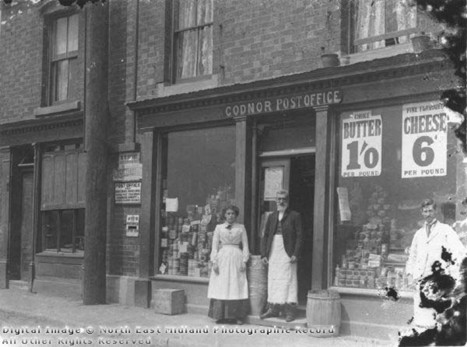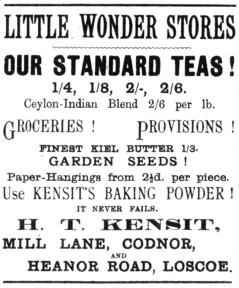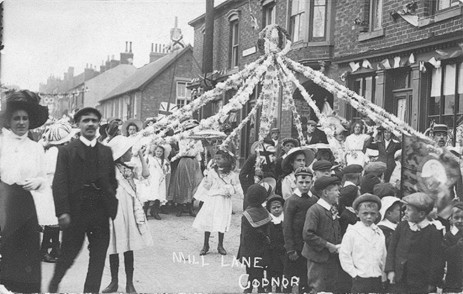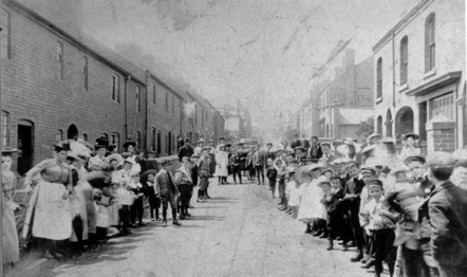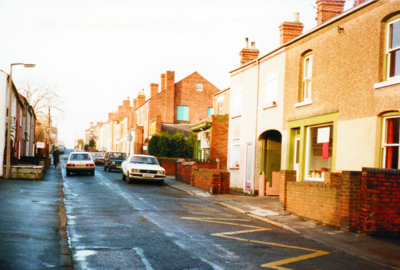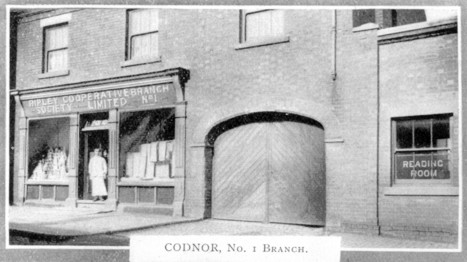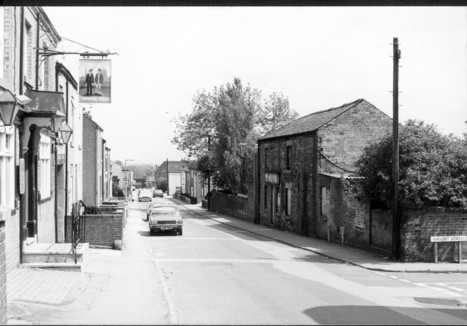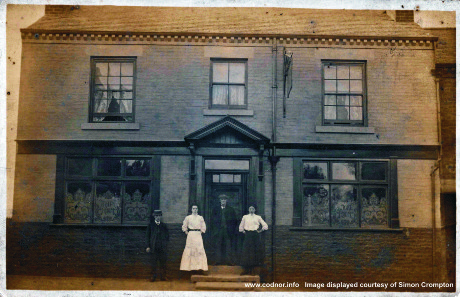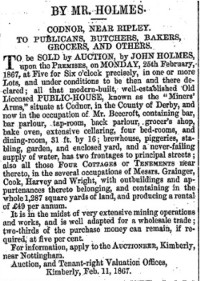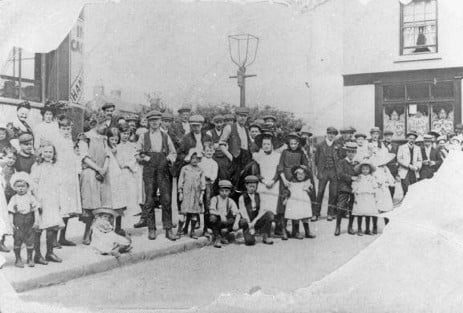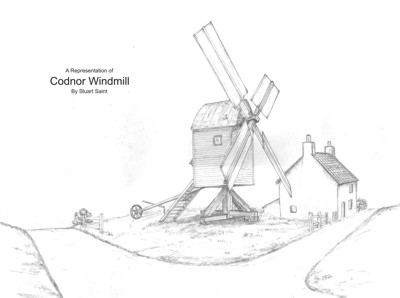
Mill Lane (Coppice Road)
Mill lane was originally known as Coppice Road, as it led to an area known as the Coppice near the top of Waingroves Road. Its name changed to Mill lane in the early 1800s, in acknowledgment of the Windmill that stood on the junction of Bakers Lane & Mill lane.
Fig.1 William Shiptons map of 1792 shows Mill Lane (identified as Coppice Road) running diagonally from left to right. You can see that the only building identified on Mill lane is the windmill at the junction of Mill Lane and Bakers Lane (then called Butterley foot road). Plot CV was Common (waste) land, allocated to the lord of the Manor. At this time it would have been Legh Hoskins Master.
Joseph Millot Severn describes Mill Lane in his book “My Village” as being the worst road in Codnor during his childhood in the mid 1800s. It was very busy with carts going back and forth between the farms and mills at the top of Mill Lane and Pease hill Waingroves. The neglected state of the road often caused many carts to get stuck in deep ruts, sometimes in bad weather it was completely unusable.
The start of Mill lane at the High Street was flanked either side by Bostocks Pork Butchers on the Left and Farnsworths Chemist on the Right. J.M. Severn recalls very few houses on Mill Lane when he was a boy. Cornfields and hawthorn hedges extended up the left hand side, also an open dyke, which carried waste water down Mill lane, behind were the shops now stand on the Market place, past Prospect Place and the chapel and down through a pipe under Jessop Street and continuing to the brook at the bottom of Heanor Road.
Fig.2 Looking up Mill Lane in about 1914. The Newsagents as we know it today was then a General store & Post Office, after it had moved from its earlier position at the chemist on the corner. Note the telegraph pole that carried the wires for the telegraph office. Also you can see the children playing in the street opposite Mill lane school. The building with the barn doors is now a Hairdresser's. Joseph Millott Severn recalls that Mr George Eyre had the shops built when he was a boy.
George was an architect and an inventor, he had a joiner’s shop and builders yard at the back, which was accessed through the archway between the shops. George patented various inventions, including types of fire grates, cash registers and window catches.
The shop just after the archway, which is now the newsagents was for many years owned by Mr Henry Thomas Kensit. The 1881 Census records Henry age 30 living in Mill lane Codnor, with his wife Mary, son age 6 (also called Henry T) and four daughters Minnie & Mary both 4, Kate 2 and Lilian only a few months old. He also owned a shop on Glasshouse hill at the junction of Holborn View were a pair semi-detached houses now stand.
Fig.3 This photo shows Henry with his son and daughter standing outside his general store and village post office in about 1910. Henry died in 1936 aged 86 and he was buried in Crosshill Cemetery. At one time he also owned the next shop, which was a sweets and confectionary, as well as the other shop below the archway, which was Kensits drapery. Note the V R (Victoria Regina) post box in the wall. Photo displayed by kind permission of the wood Collection, http://www.picturethepast.org.uk/
Fig.5 A procession celebrating the Coronation of King George V, passes Kensits shop on Mill Lane 1911.
Displayed with kind permission of Heanor & District Local History Society
Just past Kensits shop is Mill lane school, now Peverel House.For more information go to the Mill Lane School page. On the opposite side of the road to Mill Lane school, once stood the Bethesda Methodist Chapel, known locally as the "Tin Pans". More information on the Churches & Chapels page.
Fig.6 This photograph is taken adjacent to the school, looking up Mill lane. It shows the celebrations taking place to commemorate the end of the First World War hostilities in 1918. The shop on the right was for many years Marriots Plumbers and the next building further up was the Ripley Co-operative Society No.1 Branch.
Fig.7 Mill Lane 1980s, The building closest to the camera with the arched entrance used to belong to John Warren the builder and
father to Arnold Warren the cricketer.
Next is a shop that was originally
William Clarke’s butchers, later run by his son Bernard Clarke. When this picture
was taken it was a hardware store.
Fig.8 Ripley Co-operative Society’s No 1 Branch approx 1910. Built in 1877 by Messrs Warren & Sheldon, this building replaced an earlier Society shop, which was situated in a house on Mill Lane and rented at 10 shillings a year from H. Beecroft in 1873. Note the reading room built onto the side, which later became the Co-op Butchers.
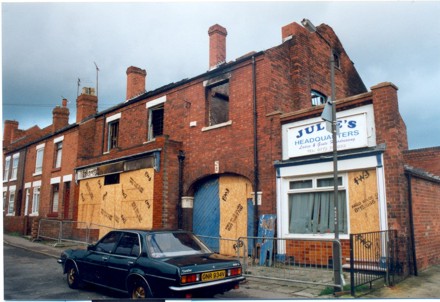
Fig.9 After the Co-op closed down on 23rd May 1987, it stood empty for many years. It was later used as a storage warehouse by a local Ripley businessman. This photograph shows the building after it was gutted by a fire around the year 2000 I think (please correct me if I'm wrong). The building was so severely damaged, it had to be demolished. Julie's Headquarters hairdressing salon moved to the building in Fig.2
Fig.10 This photo taken in the late 1980s shows the remains of Isaac Severn's bakery on the corner of Mill lane and Wright Street. The enamel sign above the door advertised 'The News Of The World' as this building was used in latter years as a news paper distribution point. The land belonged to Mr Tissington who later sold it as building land. On the Left is the Miners Arms Public House
Fig.12 This picture shows a crowd gathering at the corner of Wright Street and Mill lane, awaiting the victory day parade 1919. The Miners Arms is across the road on the right of the picture, and the corner of the Lord Byron pub on the left.
Joseph Millot Severn remembers the lord Byron pub from his childhood in the latter half of the 1800s. He recalled several busts of heads on the window shelf. You could see the silhouettes of the heads as you passed the windows at night, giving the appearance that the place was full of people.
The Windmill
Fig.13 An impression of Codnor windmill on the corner of Mill Lane and Bakers Lane.
Codnor windmill occupied a small plot of land on the corner of Mill lane and Bakers Lane (now also called Mill Lane). It does not appear on Burdett’s map of 1767 but is identified on William Shipton map of 1792. Its owner then was a Samuel Milward and later in 1801 a Royal Exchange Fire Insurance Policy gives the owner as Henry Kirkland and goes on to state the following:
'His post wind grist mill house situate a distance from his dwelling house at Codnor aforesaid, timber built £300. On the standing and going gears, millstones and machinery £50. Warranted no steam engine'
This tells us that it was a traditional post mill, which was a design of mill that had changed little from medieval times. A post mill is constructed of wood and the entire structure can be rotated on its trestle to face the wind. This is done manually by raising the steps and pushing against the tail-pole, which can be seen protruding out the back of the mill in the above illustration.
Tower mills such as the one at Heage for instance, differ in that only the top cap of the mill turns to face the wind.
The word ‘Grist’ is a term used to describe a mill that grinds grain into flour.
The policy also notes that no steam engine was present. Lots of windmill started to incorporate the newly invented steam engine to allow them to grind corn even when there was no wind. Steam engines were used more and more until eventually windmills became redundant.
The windmill is also recorded in John Farey’s 1813 edition of ‘The General View of Agriculture in Derbyshire’ Vol 2 however he doesn’t give any other details.
It appears again on Greenwoods map of 1825 but seems to have disappeared off later maps by 1835. An article in the London Gazette, May 16th 1834, suggests possible insolvency involving a Joseph Pearce maybe the reason for its short life.
The above information has been sourced from Alan Gifford’s book ‘Derbyshire Windmills Past & Present’ which is available at the Heage Windmill visitors centre.
I would also like to thank Alan for his assistance with this article.
